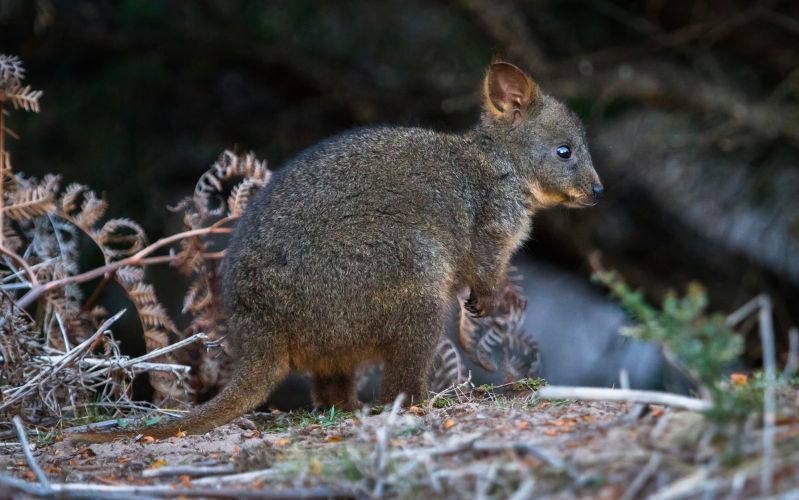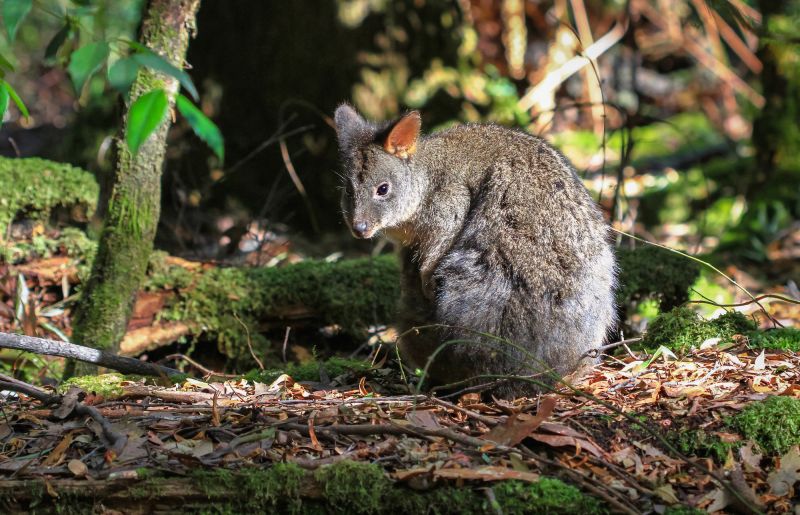Hidden among Tasmania's misty forests and button grass plains is one of the island's most endearing native marsupials - the Tasmanian Pademelon (Thylogale billardierii). This compact, ground-dwelling wallaby is found nowhere else in the world and plays an important role in Tasmania's ecosystem. Tasmania provides a stronghold for this species, where it remains relatively common and easily spotted in many protected areas.
Cultural and Ecological Importance
The pademelon has long been part of Tasmania's cultural and ecological fabric. For thousands of years, Tasmanian Aboriginal people hunted pademelons as a traditional food source and used their fur for warmth. They remain important to Tasmania's biodiversity, supporting predator species and helping to regulate vegetation through grazing.
Size and appearance
The Tasmanian Pademelon is the largest of the pademelon species and can weigh between 3.5 and 12 kilograms, with females typically smaller than males. Standing about 30–50 cm tall, they have a stocky build, short tail, and soft, dense fur which ranges from brownish-grey on the back to a reddish-brown belly.
They have small rounded ears, large hind legs for hopping, and a generally shy disposition. Their fur is well-adapted for the cool Tasmanian climate, and their colouring provides excellent camouflage in the undergrowth of wet forests and scrub.
Diet
Like all pademelons, the Tasmanian species is herbivorous. It feeds mainly on grasses, herbs, leaves, and shoots. At night, they emerge from dense forest or bushland to graze in open clearings or grassy areas.
They play a key ecological role as understorey grazers, helping to manage vegetation and influencing plant growth and regeneration patterns in Tasmanian forests.

Tasmanian Pademelon in Mt Field National Park. Image: Premier Travel Tasmania
Breeding
Tasmanian Pademelons can breed year-round, but peak breeding typically occurs in autumn and spring. After a very short gestation period of just 30 days, the female gives birth to a tiny joey that crawls into her pouch to continue development.
The joey remains in the pouch for about six months before beginning to emerge. Even after leaving the pouch, it will return to suckle until fully weaned at around 8 months of age. Like other macropods, the Tasmanian Pademelon can exhibit embryonic diapause, delaying the development of a new embryo until the pouch is vacant again.

Tasmanian Pademelon on Tasmania's mainland. Image: Premier Travel Tasmania
Where to see Tasmanian Pademelons in the wild
Tasmanian Pademelons are one of the easiest native marsupials to spot in the wild in Tasmania. They're most active at dawn and dusk and are often seen at the edge of forests, grazing quietly in clearings or along walking tracks.
Some of the best places to see them include:
Maria Island, Tasmania
Suggested Maria Island tours:
- The Maria Island Walk (4 Days) - The Maria Island Walk
- Maria Island Winter Escape Walk (3 Days) - The Maria Island Walk
- Tasmanian Wildlife Encounter (5 Days) - Premier Travel Tasmania
- Western Wilderness & Wildlife Encounter (9 Days) - Premier Travel Tasmania
Mt Field National Park, Tasmania
Suggested Mt Field National Park tours:
- Birdwatching Mt Field National Park (1 Day) - Premier Travel Tasmania
- Private Tour Tasmania Wildlife Encounter (4 Days) - Premier Travel Tasmania
- Western Wilderness & Wildlife Encounter (9 Days) - Premier Travel Tasmania
Cataract Gorge, Tasmania
Suggested Cataract Gorge tours:
- Western Wilderness & Wildlife Encounter (9 Days) - Premier Travel Tasmania
- Tasmanian Wildlife Encounter (5 Days) - Premier Travel Tasmania
Cradle Mountain, Tasmania
Suggested Cradle Mountain tours:
- Western Wilderness & Wildlife Encounter (9 Days) - Premier Travel Tasmania
- Tasmania's Western Wilderness (5 Days) - Premier Travel Tasmania
FAQs
Are Tasmanian Pademelons related to kangaroos?
Yes - they're part of the macropod family, which includes kangaroos and wallabies. Pademelons are smaller and adapted for life in denser forest habitats.
Are they only found in Tasmania?
Yes - the Tasmanian Pademelon is endemic to Tasmania and does not occur naturally on the Australian mainland. There are other pademelon species, such as the Red-legged and Red-necked, found elsewhere in Australia.
Are they nocturnal?
Yes - they are most active from dusk through the night and are rarely seen during the heat of the day.
Are they endangered?
No - the Tasmanian Pademelon is currently considered stable in the wild, but habitat protection and predator control remain important for its long-term conservation.

